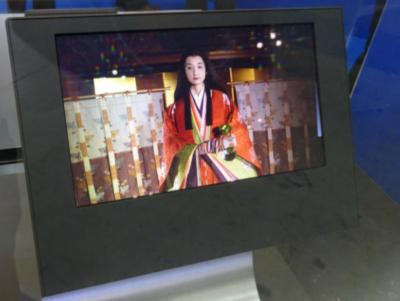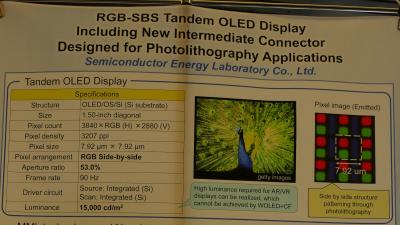 Japan-based Semiconductor Energy Laboratory (SEL) is an R&D IP company founded in 1980. SEL performs R&D in several areas, including transistors and semiconductor devices, materials and devices for OLEDs and batteries, display devices and more.
Japan-based Semiconductor Energy Laboratory (SEL) is an R&D IP company founded in 1980. SEL performs R&D in several areas, including transistors and semiconductor devices, materials and devices for OLEDs and batteries, display devices and more.
SEL has developed several key OLED material, process and architecture technologies, around flexible displays, OLED stack materials, backplanes, and more. Example SEL OLED technologies include high brightness OLED microdisplays, maskless OLED production, ExTET device architecture, foldable OLEDs and more.
398 Hase,
Atsugi-shi
243-0036
Japan
SEL demonstrates a 15,000 nits direct-emission tandem OLED microdisplay
Japan's Semiconductor Energy Laboratory (SEL) demonstrated its latest OLED microdisplay technology at Displayweek 2024. The 1.5" 3840x2880 (3207 PPI) display achieves a brightness of 15,000 by using a tandem architecture and a direct-emission design. The OLED deposition was performed using photo-lithography.
This is an impressive display, with very high brightness. It surpasses LGD's 10,000 nits microdisplay also shown at Displayweek, which uses a white-OLED with color filter design, and a microlens array. It matches eMagin's 15,000 nits microdisplay, demonstrated back in 2023 - which is a single stack device.
The Elec: Samsung Display is interested in maskless OLED production processes, looking for an exclusive license
A report from Korea's The Elec publication says that Samsung Display is highly interested in next-generation OLED deposition technologies, that are not based on a metal mask (FMM). Several companies are developing and commercialization such technologies. As these may enable higher-performance OLED production, Samsung Display is interested.
A few months ago we reported that SDC is interested in SEL's maskless production technology, and indeed the new The Elec report states that the two companies are in talks. SEL is one of the three companies we are aware of that have advanced maskless technologies, the other two being Visionox and Japan Display. Samsung Display is mostly interested in a technology that it can exclusively license as it does not want other companies to produce OLEDs using the same technology. Both Visionox and JDI are interested in using their technologies in-house, which is a problem for SDC.
Reports from Korea suggest that Samsung Display is interested in acquiring SEL's mask-less OLED production technology
According to reports from Korea, Samsung Display is interested in acquiring OLED IP and patents from Semiconductor Energy Laboratory (SEL). These patents detail an OLED production process that does not require the use of fine metal mask (FMM) evaporation.

The use of FMM to deposit and pattern OLED displays is seen as a major setback towards higher density OLED displays, and it also limits the aperture ratio. It is no wonder that Samsung is interested in such technology, as other display makers have developed similar technologies that offer massive performance boost over the standard FMM process.
On SEL's ExTET OLED device architecture
In 2016, Researchers from Japan's Semiconductor Energy Laboratory (SEL) announced a new OLED device architecture, called ExTET ('exciplex triplet energy transfer'), that can increase the performance of OLED devices. The technology was applied for a patent in 2011.
The ExTET technology, which is a modification of the host material and the EML layer in phosphorescent OLED devices, have since been introduced to commercial AMOLED panels, increasing the efficiency and lifetime of the materials, while also lowering the drive voltage.
LG Display renews its patent license agreement with SEL
LG Display announced that it renewed its patent license agreement with Japan's Semiconductor Energy Laboratory (SEL). It is not clear from the release, but it seems as if LGD has access to SEL's entire display patent portfolio.

SEL, established in 1980, engages with research and development across many fields, and is very active with OLED technology research. In recent years, SEL developed flexible and foldable OLED technologies, OLED device structures, novel OLED materials, OLED CAAC-IGZO backplanes, and more.
SEL developed a flexible OLED with embedded photo detectors between the OLED pixels
Researchers from Semiconductor Energy Laboratory (SEL) developed flexible OLED displays that incorporate organic image sensors inside the OLED pixels using side-by-side patterning. The sensors can be used as cameras for applications such as fingerprint sensing - which will work on the entire display.

SEL presented two prototypes, one a 3.07" 360x540 (212 PPI) display and the second is a 8" one with a higher pixel density of 302 PPI. SEL says that the fingerprint recognition works even when the display is bent.
Here are Semiconductor Energy Laboratory's latest foldable and high-density OLED displays
Japan's Semiconductor Energy Laboratory (SEL) is developing several exciting OLED technologies, and the company demonstrated its latest panels at SID DisplayWeek. The recently published video below shows the company's OLED technologies shown at the event:
First up is the world's smallest 8K display, a 8.3" OLED (1058 PPI) with a resolution of 7680x4320. The panel is based on a white OLED with color filter architecture and SEL's proprietary CAAC-IGZO (c-axis aligned crystalline In-Ga-Zn-O) backplane material.
Semiconductor Energy Laboratory developed a 5,291 PPI CAAC-IGZO OLED display
Semiconductor Energy Laboratory (SEL) has developed a high density OLED display (5,291 PPI) based on its proprietary CAAC-IGZO (C-Axis aligned crystalline In-Ga-Zn-O) backplane. SEL will discuss this new achievement at SID 2019.
We do not have more information, but SEL has shown some high resolution CAAC OLEDs before. In 2014 it demonstrated a 2.8" 2560x1440 (1,058 PPI) WRGB OLED display. If SEL indeed developed a 5,291 PPI OLED display on glass it is very impressive.
SEL shows a 8.3" 8K OLED with 1058 PPI, and a new foldable OLED prototype
Semiconductor Energy Laboratory (SEL) demonstrated two new OLED display prototypes, both based on the company's proprietary CAAC-IGZO (c-axis aligned crystalline In-Ga-Zn-O) backplane material.

First up is the world's smallest 8K display, a 8.3" OLED (1058 PPI) with a resolution of 7680x4320. The panel is based on a white OLED with color filter architecture.
SEL develops a new Host-Guest system that enables red phosphorescent emitters with 5.4X the lifetime
Researchers from Japan's Semiconductor Energy Laboratory (SEL) developed a novel Host-Guest system that drastically improves the lifetime of OLED emitters. The researchers report that using this system, a deep-red phosphorescent emitter achieved 5.4 times longer the lifetime compared to the same emitter with a conventional system.
The researchers will present the new system at SID DisplayWeek 2018 in May. The new system is not only highly durable, it also satisfies the red chromaticity of the BT.2020 standard.
Pagination
- Page 1
- Next page



